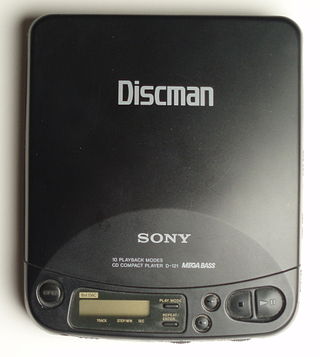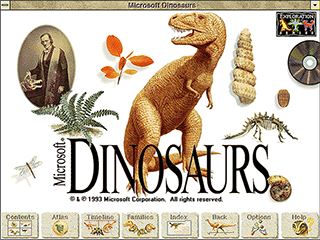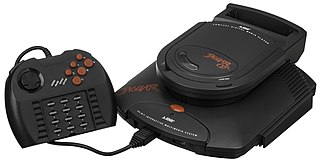
The Compact Disc-Interactive is a digital optical disc data storage format that was mostly developed and marketed by Dutch company Philips. It was created as an extension of CDDA and CD-ROM and specified in the Green Book specifications, co-developed by Philips and Sony, to combine audio, text and graphics. The two companies initially expected to impact the education/training, point of sale, and home entertainment industries, but CD-i eventually became best known for its video games.

Sony Group Corporation, formerly known as Tokyo Tsushin Kogyo K.K. and Sony Corporation (ソニー株式会社), is a Japanese multinational conglomerate corporation headquartered in Minato, Tokyo, Japan. The Sony Group comprises entities such as Sony Corporation, Sony Semiconductor Solutions, Sony Entertainment, Sony Interactive Entertainment, Sony Financial Group, and others.

Walkman, stylised as WALKMAN (ウォークマン), is a brand of portable audio players manufactured and marketed by Japanese company Sony since 1979. The original Walkman started out as a portable cassette player and the brand was later extended to serve most of Sony's portable audio devices; since 2011 it consists exclusively of digital flash memory players. The current flagship product as of 2022 is the WM1ZM2 player.
A DVD player is a device that plays DVDs produced under both the DVD-Video and DVD-Audio technical standards, two different and incompatible standards. Some DVD players will also play audio CDs. DVD players are connected to a television to watch the DVD content, which could be a movie, a recorded TV show, or other content.

Videodisc is a general term for a laser- or stylus-readable random-access disc that contains both audio and analog video signals recorded in an analog form. Typically, it is a reference to any such media that predates the mainstream popularity of the DVD format. The first mainstream official Videodisc was the Television Electronic Disc (TED) Videodisc, and the newest is the 4K Ultra HD Blu-Ray Disc. As of September 2023, the active video disc formats are Blu-ray Disc, DVD, and in other regions because of the price difference from DVD, Video CD (VCD) and SVCD.

The Data Discman is an electronic book player introduced to the Western market in late 1991 or early 1992 by Sony Corporation. It was marketed in the United States to college students and international travelers, but had little success outside Japan. The Discman product name had originally been applied to Sony's range of portable CD players such as the Sony Discman D-50, first released in 1984.

Discman was Sony's brand name for portable CD players. The first Discman, the Sony D-50 or D-5, was launched in 1984. The brand name changed to CD Walkman, initially for Japanese lineups launched between October 1997 and March 1998, and then entirely in 2000. Discman and CD Walkman players are no longer produced.

Microsoft Bookshelf is a discontinued reference collection introduced in 1987 as part of Microsoft's extensive work in promoting CD-ROM technology as a distribution medium for electronic publishing. The original MS-DOS version showcased the massive storage capacity of CD-ROM technology, and was accessed while the user was using one of 13 different word processor programs that Bookshelf supported. Subsequent versions were produced for Windows and became a commercial success as part of the Microsoft Home brand. It was often bundled with personal computers as a cheaper alternative to the Encarta Suite. The Encarta Deluxe Suite / Reference Library versions also bundled Bookshelf.
Photogenics is raster graphic editing software produced by Idruna Software.

A portable CD player is a portable audio player used to play compact discs. The first audio player released was the Discman D-50 by Sony.
Science Sleuths was a series of interactive videos that were produced by Videodiscovery, Inc. from 1991 to 1996. The series was first published on LaserDisc with accompanying manuals. Certain titles were later converted to the CD-ROM format.

A CD-ROM is a type of read-only memory consisting of a pre-pressed optical compact disc that contains data. Computers can read—but not write or erase—CD-ROMs. Some CDs, called enhanced CDs, hold both computer data and audio with the latter capable of being played on a CD player, while data is only usable on a computer.

MicrosoftEncarta is a discontinued digital multimedia encyclopedia published by Microsoft from 1993 to 2009. Originally sold on CD-ROM or DVD, it was also available online via annual subscription, although later articles could also be viewed for free online with advertisements. By 2008, the complete English version, Encarta Premium, consisted of more than 62,000 articles, numerous photos and illustrations, music clips, videos, interactive content, timelines, maps, atlases and homework tools.

Microsoft Dinosaurs is an educational interactive CD-Rom developed by Microsoft, themed around dinosaurs.

The Atari Jaguar CD is a CD-ROM peripheral for the Jaguar video game console.

A Passion for Art: Renoir, Cezanne, Matisse, and Dr. Barnes is a 1995 interactive CD-ROM by Corbis.

Volcanoes: Life on the Edge is a 1996 interactive CD-ROM published by Corbis. It recounts the expeditions by photojournalist Roger Russmeyer to volcanoes around the world.

3-D Dinosaur Adventure is an educational video game by Knowledge Adventure released on CD-ROM for MS-DOS compatible operating systems in 1993. Versions for Macintosh and Windows 3.x were published in 1996. A 1997 re-release and an updated version for Macintosh and Microsoft Windows is titled 3-D Dinosaur Adventure: Anniversary Edition.

The IBM ThinkPad 365 is a notebook computer series developed by IBM and manufactured by ASE Group. It was released in North America in November 1995, and was the successor of the ThinkPad 360 series. The series had 8 models that were released before being discontinued, and was succeeded in 1997 by the ThinkPad 380 series.
Microsoft Multimedia Viewer or simply Viewer was a multimedia authoring tool for Windows built upon WinHelp online help format. The toolkit was used to develop Microsoft's early Windows CD-ROM reference titles like Encarta, Cinemania and Bookshelf, as well as for a number of third-party multimedia titles for Windows 3.1 like the CD-ROM edition of The Merck Manual.
















